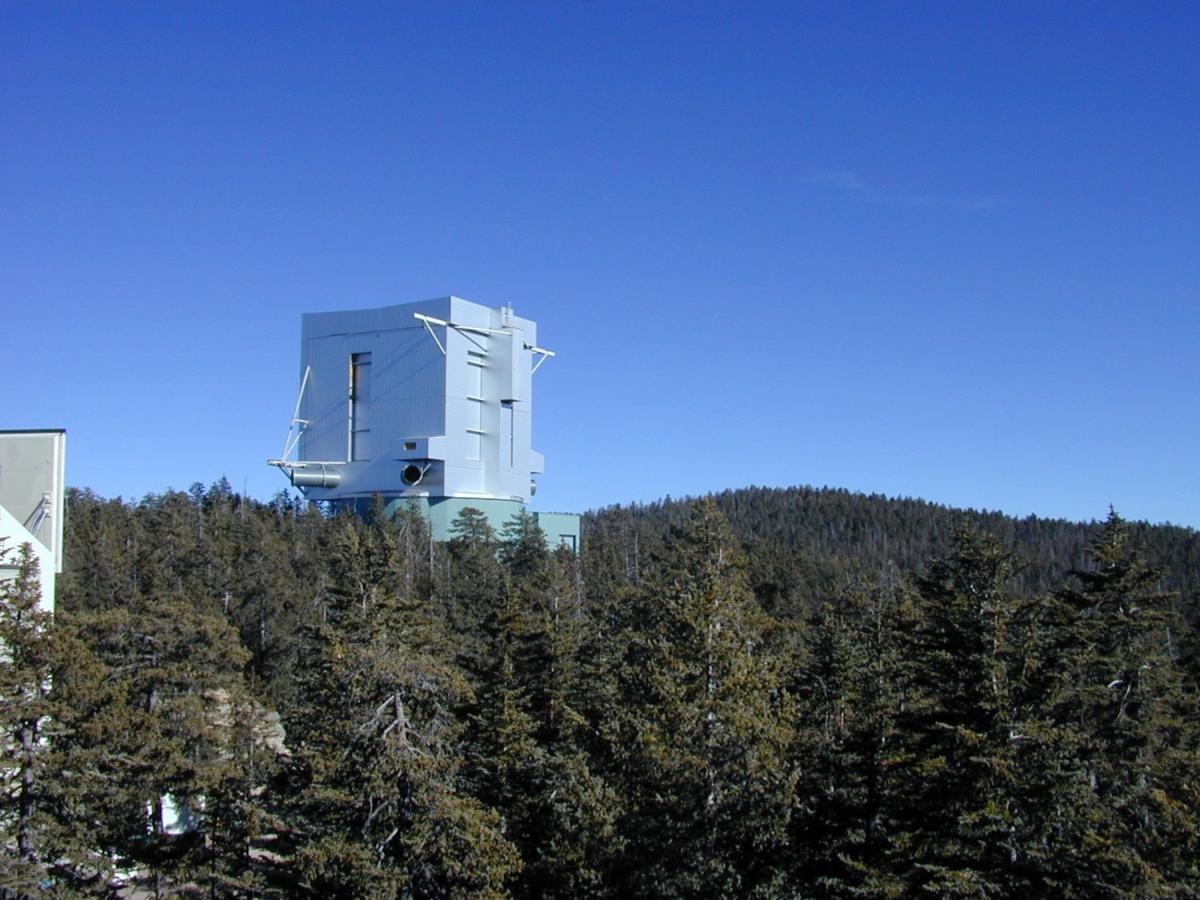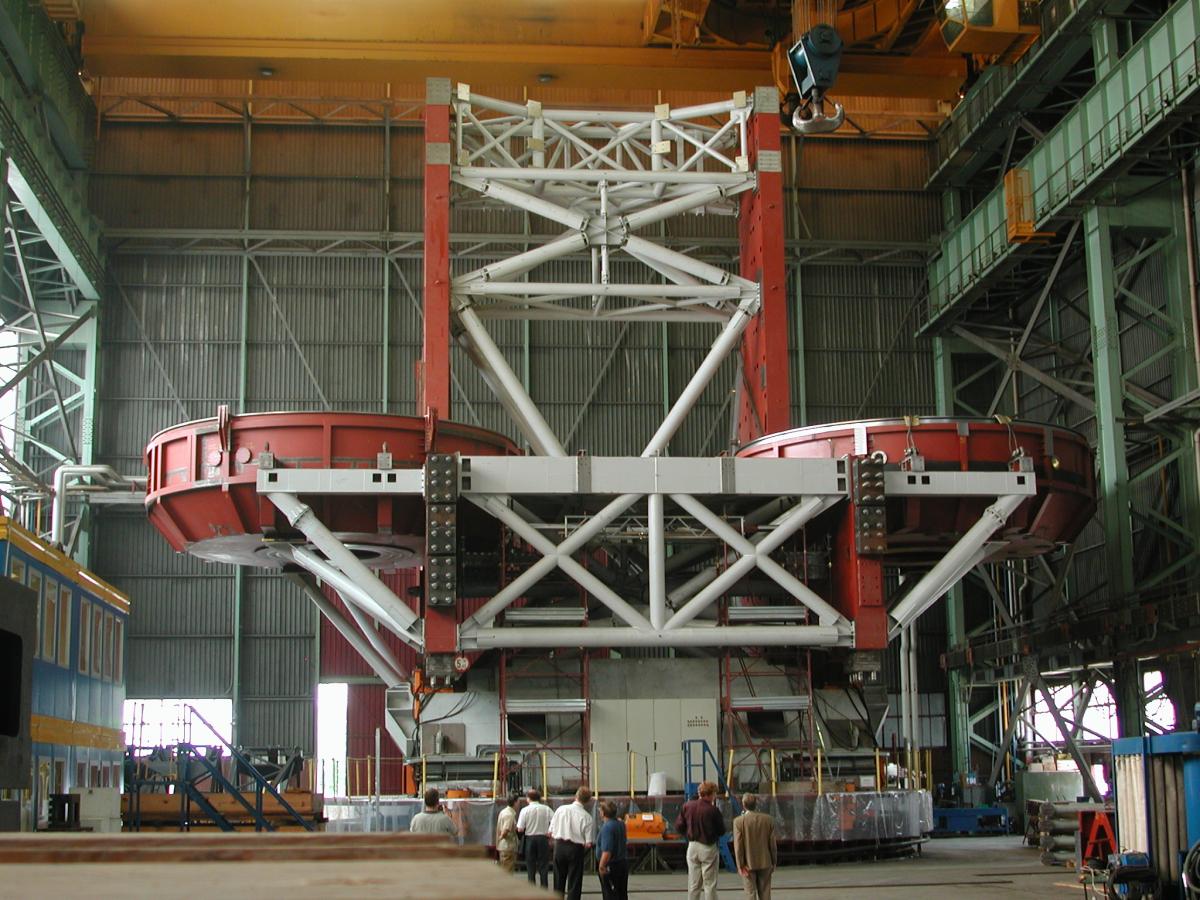The Large Binocular Telescope
Regarding its optical layout and physical dimensions the Large Binocular Telescope (LBT) represents a revolutionary and fascinating new type of astronomical interferometer. In contrast to all other interferometric telescopes (either already operational or currently under construction) the optical layout of the LBT resembles a Fizeau interferometer, with both primary mirrors sharing a common mount (see Fig. 1).
Fig. 1: Schematic representation of the optical layout of the Large Binocular Telescope. The diameter of the two identical primary mirrors is 8.4 meters and their linear separation (centre to centre) amounts to 14.4 meters. For interferometric observations the incoming light of the two optical paths (sketched in transparent blue) is reflected horizontally at the tertiary mirror (located slighty above the primary mirrors) towards the central platform of the telescope. (Click here to view an animated rendering of the LBT telescope in MPEG format.)
This special optical layout of the telescope has two important consequences in interferometric operation:
-
The baseline of a Fizeau interferometer is not fixed to the ground (like at VLTI or Keck I & II, where the baselines are defined by the relative geographical locations of the individual telescopes) but is fixed to the movable common mount of the two mirrors. Therefore, while the pointing of the telescope follows the apparent nightly motion of an observed source on the sky, the geometrical projection of the baseline onto the imageplane (the plane of the incoming wavefront rectangluar to the line of sight) remains constant in time at 14.4 meters and the angular resolution of the interferometer remains constant in time as well, because it is a linear function of this baseline. As a result the LBT allows direct interferometric imaging of an astronomical target without the need of complicated optical delays lines to compensate changing baseline projections during an observation.
-
The linear separation of 14.4 meters between the centres of the two primary mirrors is small compared to their respective diameters of 8.4 meters. While the large diameters of the primary mirrors ensure a large light-collecting area of 110 m² and therefore a high sensitivity of the telescope for faint sources, the separation of the two mirrors defines the angular resolution of the interferometer. At wavelengths of the near-infarred H band, the close baseline of 14.4 meters for example leads to an optical resolution of 9 milliarcseconds. This is only a moderate value in comparison to the high resolution of non-Fizeau interferometers (e.g. VLTI or Keck I & II) in the range of microarcseconds, but with respect to the size-limitation of currently available semiconductor detector-arrays it allows the coverage of more than 30 x 30 arcseconds² on a single array with 2k x 2k pixels².
To summarize the various implications of the two points discussed above, the LBT interferometer will offer an exceptional and so far unprecedented combination of wide field of view (15 to 120 arcseconds depending on the used detector array, the observed wavelength and the performance of the complex adaptive optic systems), high angular resolution (9 milliarcseconds at 1.25µm) and large collecting area (110 m²). While other astronomical interferometers (e.g. VLTI or Keck I & II) can reach higher angular resolutions, their field of view will be less than one arcsecond and too small to help answering many interesting questions.
Currently the various parts of the complex telescope system (enclosure, structure, electro-mechanics, mirrors, adaptive optics and cameras) are under construction at several universities and research institutes in the United States of America, Germany and Italy which are contributing to the Large Binocular Telescope Corporation. The non-interferometric first light of the telescope with only a single primary mirror is scheduled for spring 2005 and the first interferometric observations with both primary mirrors installed are planned to start later in the same year.
Table 1 shows a list of all organisations which are direct members of the Large Binocular Telescope Corporation and their respective share on the LBT budget (approx. US$ 88.000.000). As can be seen in the list, the I. Physikalische Institut of the University of Cologne is not a member of the German shareholder LBTB and therefore is not involved in the general commissioning and operation of the LBT itself. The contribution of our institute is exclusively focused on the construction and operation of LINC, the visible and near-infrared interferometric camera system for this telescope.
| Organisation | Nat. | Share |
| University of Arizona, Arizona State University, Northern Arizona University | USA | 25% |
| Large Binocular Telescope Beteiligungsgesellschaft (LBTB) (represented by the Max-Planck-Institut für Astronomie, Landessternwarte in Heidelberg, Astrophysikalisches Institut in Potsdam, Max-Planck-Institut für Extraterrestrische Physik and Max-Planck-Institut für Radioastronomie) | D | 25% |
| Italian astronomical community (represented by the Osservatorio Astrofisico di Arcetri) | I | 25% |
| Research Corporation (represented by the Ohio State University, University of Notre Dame, University of Minnesota and University of Virginia) | USA | 12.5% |
| Ohio State University | USA | 12.5% |
Table 1: International universities and research institutes participating in the Large Binocular Telescope Corporation.
The Large Binocular Telescope will be located at an elevation of 3200 meters on Mt. Graham near Tucson, Arizona (USA), and the construction of the telescope enclosure as well as the provision of electrical power, water and external data communications at the telescope site are organised and headed by the local University of Arizona. The picture of the LBT site presented in Fig. 2 has been taken in late 2001 and shows the outer shell of the telescope enclosure mostly finished, with the remaining work concentrating mainly on its interior.
Fig. 3 shows a picture taken during the pre-erection of the telescope structure in Autumn 2001 at Ansaldo Inc. at Milan, Italy. This test assembly included all crucial parts of the mechanical structure and electrical drive system of the telescope in order to proof the specified operation and interaction of the individual components, and to measure and analyse detailed flexure parameters. The telescope system was fully steerable during this test-erection.
As the results of this test confirmed the specified operation of most components and only revealed the need of minor refinements in few parts, the structure has been disassembled during the following winter and made ready for its shipment to the LBT site in the United States.

